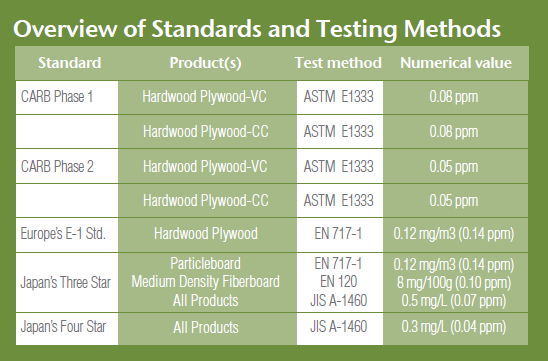
Formaldehyde
Formaldehyde is a naturally occurring and man-made chemical compound used to manufacture many products. It is a gas in its natural form, and inhalation is the primary route of entry into the body. In the atmosphere, formaldehyde gas is commonly formed when hydrocarbons are broken down, so gasoline and its emissions are a likely source of daily exposure. In nature, formaldehyde is formed as plant matter decays and in part comes from the chemical metabolism of foliage. Thus, it is no surprise that it is found in untreated wood. Formaldehyde is also manufactured in large quantities and typically sold as a liquid in solution. It can be found in thousands of common consumer products from deodorant, cosmetics, bathroom cleaners, to insulation, carpets, and furniture.
In 1992, the California Air Resources Board (CARB) listed formaldehyde as a toxic air contaminant with the highest air concentration typically found indoors. This was not the first time formaldehyde had come under scrutiny due to air quality concerns. Rules enacted by the Department of Housing and Urban Development (HUD), and the states of Wisconsin and Minnesota aiming to reduce ambient air formaldehyde levels in manufactured housing stem all the way back to 1983. CARB’s Composite Wood Products Airborne Toxic Control Measure (ATCM) was finalized in 2008 in order to reduce Californian exposure to airborne formaldehyde. This standard restricted formaldehyde emissions for hardwood plywood (HWPW), particleboard (PB), and medium density fiberboard (MDF), and applied to products sold, supplied, used, imported for sale, or manufactured for sale in California. As a result, panel manufacturers, fabricators of finished goods, distributors, importers, and retailers were required to utilize and distribute compliant composite wood products. Ultimately, the CARB formaldehyde emission standards would be mirrored on a federal level with the Formaldehyde Standards for Composite Wood Products Act being signed into law to become the Toxic Substances Control Act (TSCA) Title VI in 2010. Until March 22, 2019, products could be labeled as CARB ATCM Phase II or TSCA Title VI to comply with the new standard. After this date, composite wood products had to be labeled as TSCA Title VI compliant. By including provisions for laminated products, product-testing requirements, labeling, recordkeeping, and import certification, the final rule ensured that composite wood products in the U.S. were in compliance with the emissions standards.
CARB
In the United States, formaldehyde is regulated by a number of agencies. Perhaps the biggest and the most recent standard to regulate formaldehyde came in April of 2007. The California Air Resources Board (CARB) passed a law limiting the amount of formaldehyde emissions from composite wood products. Aimed at manufacturers of particle board, medium density fiberboard (MDF) and interior plywood, this standard will restrict formaldehyde to very low limits.
U.S California Airborne Toxic Control Measure to Reduce Formaldehyde Emission from Composite Wood Products:
All testing must be conducted in accordance to ASTM E1333 (Large Chamber Test Method). This applies to panel manufacturers, distributers, importers, fabricators, and retailers of hardwood, plywood, particleboard, and medium-density fiberboard as well as finished goods containing those products that would be sold or supplied to California.
Research conducted during the promulgation of the standard clearly showed that polyvinyl acetate, soy-based and MDI based adhesives had negligible levels of formaldehyde, if any, during the chamber testing. This standard exempts these adhesive products from third-party testing but requires the board manufacturers to perform ongoing testing.
While formaldehyde-free adhesives are certainty going to be preferred to other adhesives for the new CARB standard, it is not mandatory that all adhesives used be formaldehyde-free. Many low-emitting formaldehyde adhesives will pass the strictest limits of the new CARB standard. One key point, however, is that chamber testing is performed on wood with the adhesive; the wood almost always contains some natural amount of residual formaldehyde. By using a formaldehyde-free adhesive, a manufacturer can eliminate the possibility that any formaldehyde emissions might come from the adhesive in the composite wood. It provides the assurance that the adhesive is not going to contribute to the testing results. This is the peace of mind many composite wood product manufacturers seek. Fortunately, at Franklin we considered this in the development of our newest line of wood adhesives; we now have adhesives that will meet this need.
Summary of formaldehyde regulations and testing methods:
Below is a table that summarizes the various formaldehyde regulations:

Our green products:
Based on our knowledge of VOCs and formaldehyde, we feel confident most of our frequently used products used to produce hardwood plywood would pass phase 2 CARB standards. Our table illustrates some of our raw adhesives that would perform well in testing and not contribute to formaldehyde chamber emissions or high VOC levels. This table serves only as a guide. CARB as well as other international regulations, require the composite wood manufacturer to conduct third party testing of your substrate with the adhesive you are using to show passage of the regulation. the test is not designed for the raw adhesive.

If you would like further guidance on using our products to meet CARB standards or additional testing information, please feel free to contact us at 1.614.443.0241.
This brochure was printed from the most current information available at the time.
Please refer to the most recent CARB guidelines for complete accuracy.